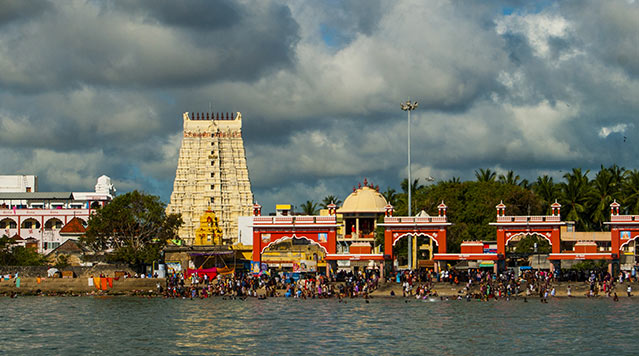Rameshwara Sri Ramanathaswamy (Jyotirlinga) Temple- Ramanathapuram

Address
Rameshwara Sri Ramanathaswamy (Jyotirlinga) Temple- Ramanathapuram District, Rameswaram, Tamil Nadu 623526, IndiaPhone: 04573 221 223
Deity
Ramanadhaswamy (Shiva) Parvatavardini (Parvati)
Introduction
- Name: Ramanathaswamy Temple (Rāmanātasvāmi Kōyil) is a Hindu temple dedicated to Lord Shiva located on Rameswaram Island in Tamil Nadu, India.
- Significance: It is one of the twelve Jyotirlinga temples, sacred to Shiva. The temple is also a part of the 275 Paadal Petra Sthalams, where the revered Nayanars (Appar, Sundarar, and Tirugnana Sambandar) have glorified the temple through their devotional songs.
- Historical Expansion: The temple was expanded during the 12th century under the Pandya Dynasty. The principal shrines and sanctum were renovated by Jeyaveera Cinkaiariyan and his successor Gunaveera Cinkaiariyan of the Jaffna kingdom.
- Unique Feature: The temple boasts the longest corridor among all Hindu temples in India.
- Pilgrimage Significance: The temple is a holy pilgrimage site for Shaivites, Vaishnavites, and Smarthas. It is considered one of the Char Dham sites, alongside Badrinath, Puri, and Dwarka. Though the exact origins are unclear, the temple’s association with Sankaracharya’s Advaita philosophy adds to its spiritual importance.
Puranic Significance:
- Ramayana Connection: According to the Ramayana, Rama (the seventh avatar of Vishnu) prayed to Shiva at this site to absolve him of the sin of killing Ravana, who was a Brahmin by birth.
- The Two Lingams: Rama wanted a large Shiva Lingam for worship, so he instructed Hanuman to bring one from the Himalayas. However, due to Hanuman’s delay, Sita built a small Lingam out of sand, which is now believed to be the Ramalingam in the sanctum. Alongside it, there is a Vishwalingam brought by Hanuman from Kailash. Rama instructed that the Vishwalingam should be worshipped first, a tradition that continues to this day.
- Temple Architecture: The temple features high compound walls (madil), with the eastern and western towers (Gopurams) being particularly prominent. Inside, there are extensive corridors formed by pillars, which are highly characteristic of South Indian temple architecture.
Beliefs:
- Tīrthas: The temple area and its surroundings house 64 Tīrthas (holy water bodies). According to the Skānda Purāṇa, 24 of these Tīrthas are considered especially important. Bathing in these Tīrthas is considered as purifying and equivalent to penance. Out of these, 22 Tīrthas are located within the temple premises itself.
- Theerthams Represent Arrows: The 22 Tīrthas are associated with the 22 arrows in Rama’s quiver, with the first one being Agni Theertham, representing the sea. Devotees are traditionally expected to bathe in these Tīrthas before entering the sanctum sanctorum.
Special Features:
- Early Structure: Initially, the temple was a thatched shed. The present structure was the result of contributions by several rulers and dynasties over the centuries, particularly the Setupatis of Ramanathapuram.
- Key Contributions: In the 17th century, Dalavai Setupati constructed part of the eastern Gopuram. Later, in the 18th century, Muthuramalinga Setupati built the famous third corridor, known as Chokkatan Mandapam.
- Statues of Setupatis: Statues of Muthuramalinga Setupati and his ministers can be found at the western entrance to the third corridor.
- Hanuman’s Tail Scar: There is a significant scar on the Shivalinga, said to be the trace of Hanuman’s tail. This marks the spot where Hanuman attempted to remove the Ramalingam to dedicate the Vishwalingam brought from Kailash.
Festivals:
- The temple celebrates numerous festivals, including:
- Mahashivaratri
- Badatra Mela/Fete: Held on the 15th day of the month of Ashadha (Rainy season), this is a grand festival celebrated with much fanfare and festivities.
Century/Period/Age
12th century
Managed By
Hindu Religious and Charitable Endowments (HRCE)
Nearest Bus Station
Rameshwara
Nearest Railway Station
Rameshwara
Nearest Airport
Madurai









